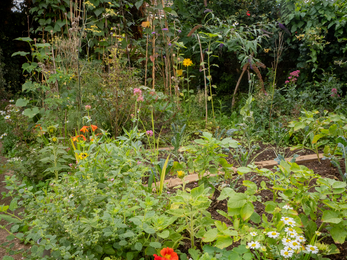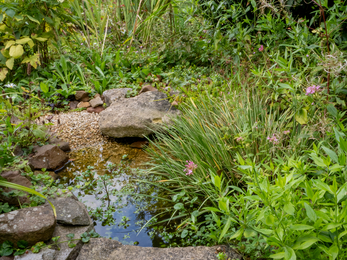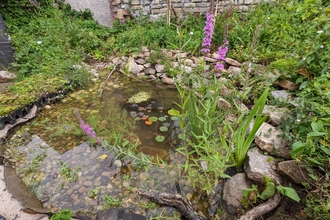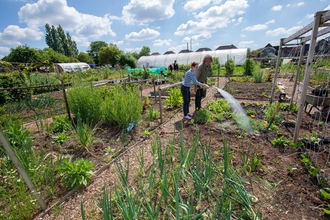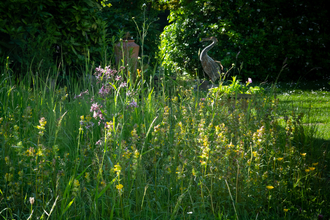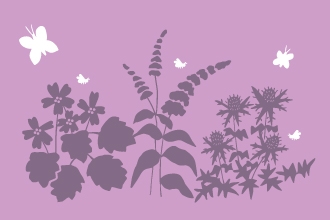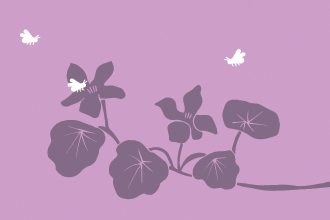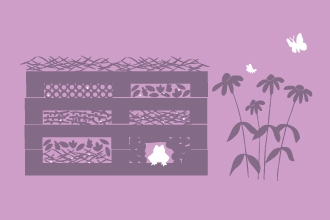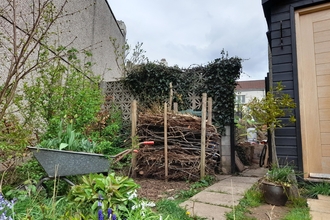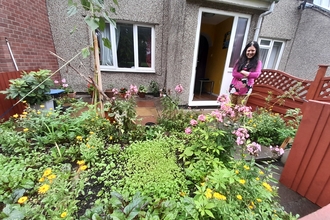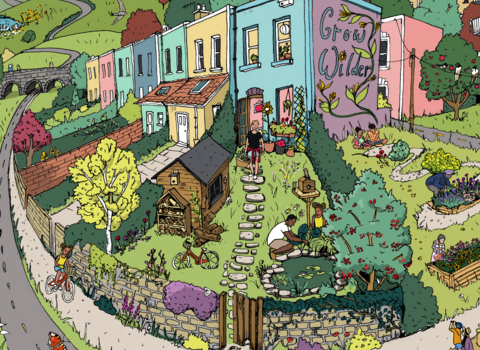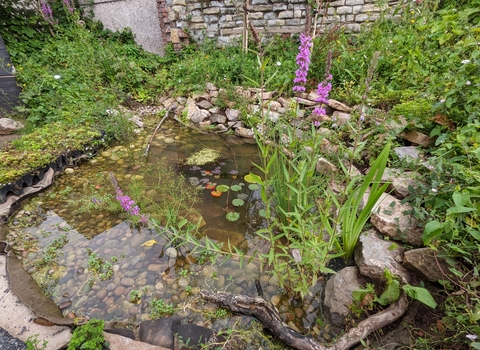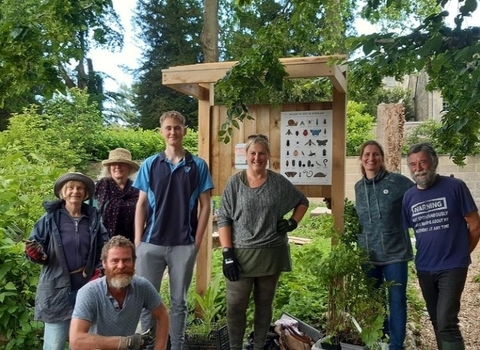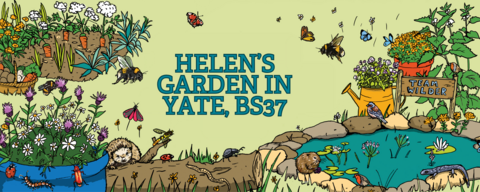
Hannah Bunn
Individual garden: Helen Alloush
Name: Helen Alloush
Category: Individual garden in the wildlife gardening competition 2023
Area: South Gloucestershire, Yate
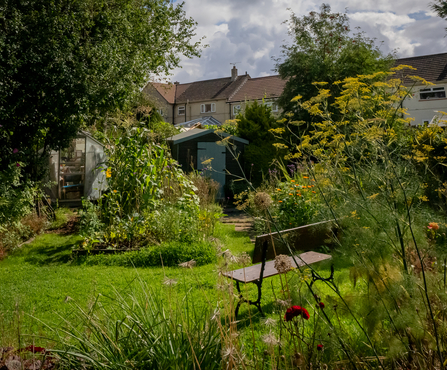
Stephanie Chadwick
What makes your garden wildlife friendly?
Helen: In my garden a range of wildlife can find the shelter, food and water that they need to help them thrive. There is provision for those dropping in for a short visit, whilst others find what they require to establish a more long term presence here and stay or return year after year to raise new generations.
Projects undertaken especially to help nature include a log pile/dead hedge, a small pond, and conversion of part of the lawn to a mini wildflower meadow. I've made nest boxes for bluetits and great tits, a bird table, hedgehog hibernaculum, and currently under construction is a large insect hotel. All these were built entirely using leftover wood and scrap materials, at almost no cost at all!
My garden gives nature some space and the opportunity to do its own thing. It offers hedges, trees, flowers, some of these specially chosen to attract insects or birds, while native plants or "weeds" which have value to wildlife are allowed and encouraged to grow. Areas of uncut grass, water, abundant ivy and the absence of pesticides and herbicides all help to make my garden a welcoming place for wildlife.
Tell us what you love about your garden
I love that my garden provides a haven for me and my family as well as for wildlife - a place where I'm happy, that brings nature right to the doorstep and where there is always something new to discover or delight in. I love that by just stepping outside my door, depending on the season, I might hear the blackbird's melodious song, or the cheerful chattering of goldfinches coming to feed on flower seedheads; that I might hear grasshoppers chirping or see Ringlet butterflies bobbing among the long grasses, or cross paths with a hedgehog on its nightly foraging.
I also love and feel excited when I see positive results from my efforts, such as Brimstone butterflies laying eggs on the hedge I had planted for them, then their caterpillars growing up there; bluetits nesting and raising young in the box I made for them; a hedgehog using the shelter I had built for it. I love the little surprise discoveries, like the painted lady caterpillar found growing up on a thistle, and the juvenile sparrowhawk that spent a few hours in the garden one day.
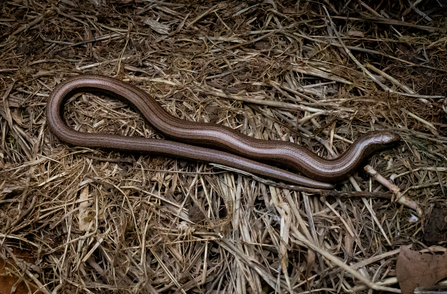
Stephanie Chadwick
What wildlife have you seen in your garden?
We have seen a wide range of birds from wrens, and even the occasional goldcrest, up to sparrowhawks. Some recent interesting additions to the usual garden birds are a pair of blackcap warblers, which visited the bird feeders throughout the winter. Jays and jackdaws have also become frequent winter feeders and a great spotted woodpecker was seen eating nuts. Occasionally, a flock of long-tailed tits descends on the garden, hopping about the trees - delightful to see and hear! In the largest trees (an old, overgrown cypress hedge) and the ivy that grows on them, we can now count blackbird, wood pigeon, starling, magpie, robin, wren, and recent newcomers dunnock, as regular nesters. Not all get along harmoniously. The magpies especially cause commotion now and then, attempting to attack other birds' nests. However, they themselves are sometimes harassed by jackdaws. We have twice witnessed wood pigeons, abundant here, suddenly swiped as prey by a sparrowhawk.
We see hedgehogs (last year, a mother with two hoglets were resident), also slowworms of all sizes, which belong to a thriving colony. These are sometimes found sunbathing in large numbers in their favourite place, a former compost heap covered with a corrugated sheet. Frogs have been spotted taking a dip in the pond.
A very large variety of insects and other invertebrates are seen - too many to name here individually. Over the last few years, since taking actions to help nature, I have noticed new species appearing and increased numbers of others, especially solitary bees. Leaf-cutter bees are now a common sight, as are several species of mining and bumble bees. A new favourite, the hairy-footed flower bee, is now seen often, especially when brassicas are allowed to flower.
Hoverflies and bee mimics are also more various and numerous, as are beetles, and butterflies. Seven-spot ladybirds are among those observed to complete their lifecycle in the garden. Dragonflies and damsel flies are more frequently seen and bats hunting overhead are a regular sight at dusk.
My actions for nature have introduced or encouraged Meadow Brown, Ringlet, Gatekeeper, Holly Blue, Brimstone, Small Skipper and Speckled Wood butterflies; Scarlet Tiger, Cinnabar and Mullein moths; Speckled bush cricket and Field Grasshopper - to name but a few!
Helen was a finalist!
Stephanie Chadwick
Be patient - start with small changes, rather than many ambitious projects, and progress one step at a time. After a while you will surely see positive results!
Keep the tiny creatures happy - the insects and invertebrates - by providing the plants and environment that they require. They naturally attract larger food chain members into your garden. They are fascinating to observe and learn about, which has led me to appreciate them so much more!
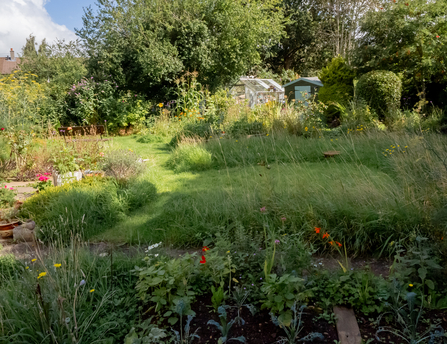
Stephanie Chadwick
Feeling inspired?
Helen has created a stunning and effective wildlife garden and gains huge enjoyment from gardening this way and appreciating the wildlife around her. Here are a few features and actions you could take for yourself, with advice from the Team Wilder Community Ecologist:
Mini Meadows and wild patches - It was great to see the longer grass where you mentioned that you only cut certain patches and leave the rest. This is good for over wintering invertebrates, amphibians and the slow worms! It is best to cut the remaining areas of the mini meadow once the plants have flowered – this can be early-late August. You might want to identify what wildflowers you have in the meadow and see when their flowering times are in order to determine when to cut (or just through observation!). In these areas that you cut once a year, you might want to plant some plug plants in so that the diversity increases.
Plug plants that would be good to see are common knapweed, self heal, yarrow and birds foot trefoil, as these are great for pollinators. You can find additional species on the suppliers websites below! I also recommend that you rotate the areas that you leave over winter each year (e.g. cut different parts of the meadow each August).
Plantlife: meadows
Plantlife: meadow management
Magnificent Meadows
Grow Wilder offers native, ethically sourced seeds and wildflowers with a local origin of Bristol. Many of the wildflower seeds have been collected from Avon Wildlife trust reserves.
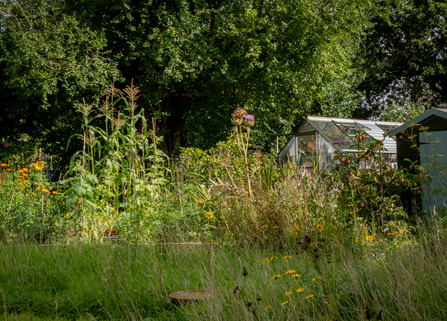
Stephanie Chadwick
Great that you have planted early and late flowering plants within the garden to extend the growing season. this resource lists particular species:
The best plants for bees and pollinators
Advice for habitat creation: There are many effective ways to create habitat space for wildlife in gardens of all shapes and sizes - at home and in teh community.
Team Wilder wildlife ponds
Team Wilder wildflower meadow creation
Team wilder dead hedges
Resources
For more amazing inspiration see Helen's instagram: @helens_lens_

West of England Combined Authority and Natural History Consortium
Be part of Team Wilder
Feeling inspired by this wildlife garden? Try something for yourself at home, in your community, school, business or land, no matter the size.
All actions for nature collectively add up and makes a difference for people and wildlife.
Share your actions for nature, like Helen, and motivate others to do the same.
Log your actions for nature on the map

